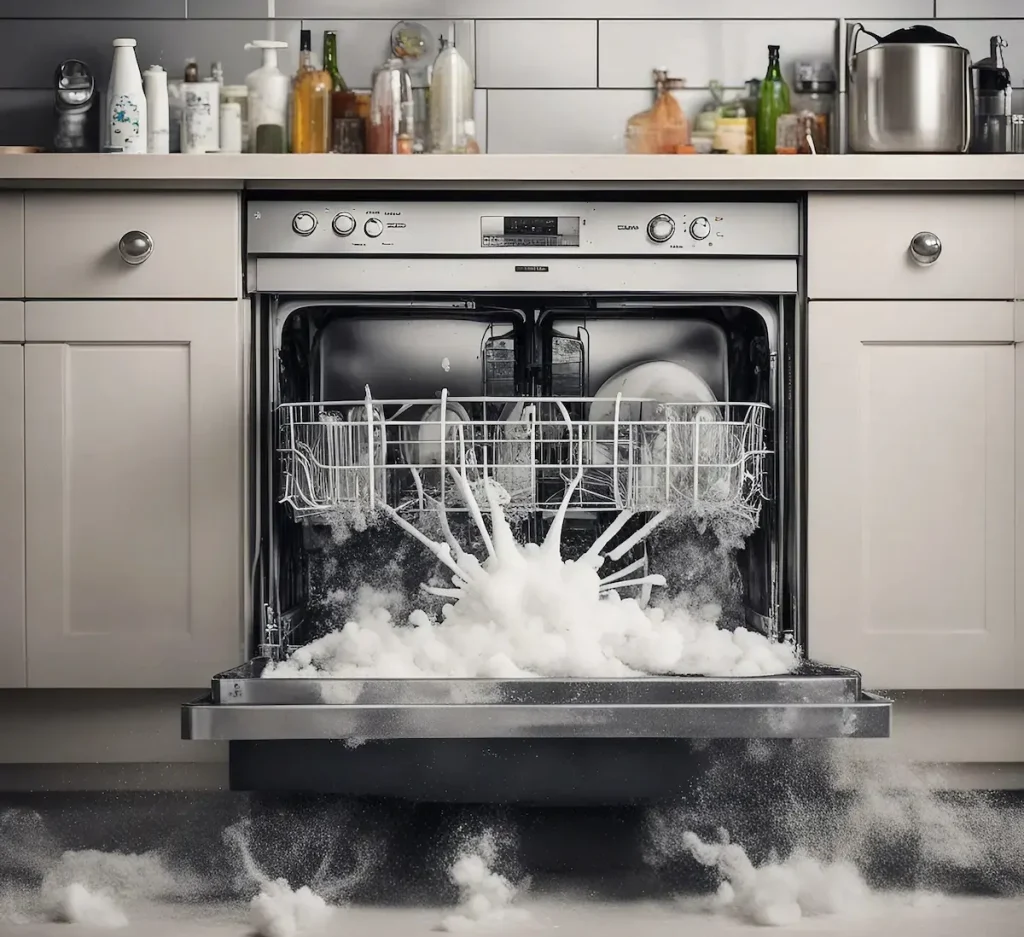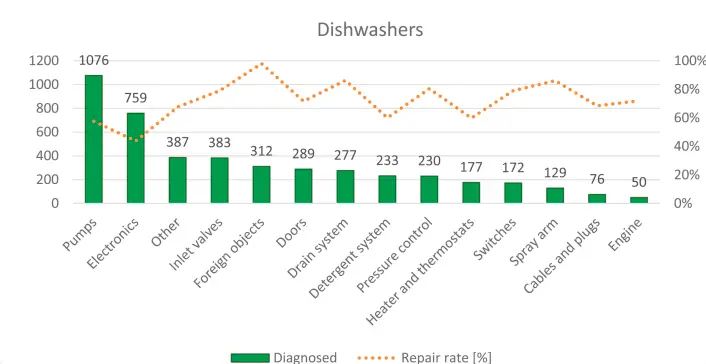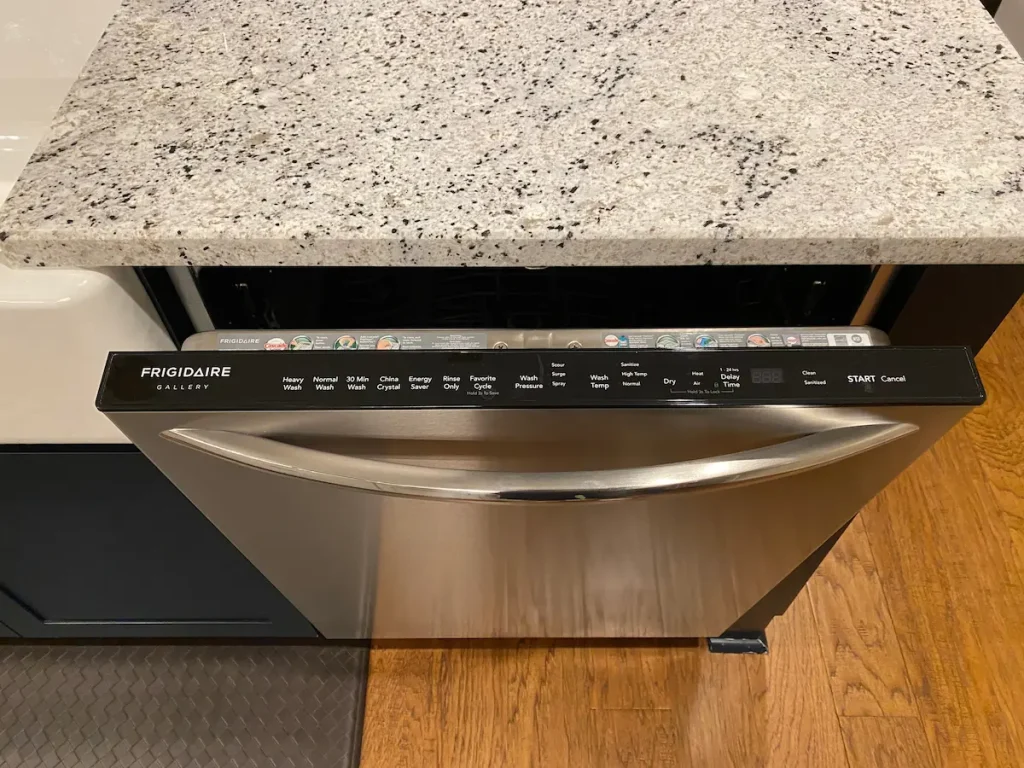
IN A NUTSHELL:
Studies have shown that the average lifespan of a dishwasher across all brands and models is 12 years, assuming you run it 4-5 times a week. The most common problems involve the pumps, electronics, drain and the door.
But I plan to beat the odds by keeping my dishwasher (Luke Skywasher) working for 17 years. I’m currently on year three, and here’s what I’m doing to extend its lifespan:
- Cleaning the filter and drain hose at the end of each month to clear out any buildup.
- Running more frequent, smaller loads to avoid overcrowding the racks.
- Leaving the door open by 2″ to reduce the chances of mold and problems with the door or latch.
Here’s a surprising fact: The national average cost for a new dishwasher is now $970. And that doesn’t take into account the cost of professional installation, which can add on another $200.
I’m sure you can probably think of better ways to spend $1,200. I know I can!
So I decided to turn this into a challenge for myself:
What are the steps that I can take today to keep my dishwasher working as long as possible?
After all, I like my dishwasher. Barring any extraordinary advancements in dish washing technology, I could see myself still being perfectly happy with it years from now.
Everything in this article is based on my own research and testing, so your mileage may vary. I definitely don’t expect that many people plan to hold on to their dishwasher for the next 20 years!
But if you care about the lifespan of your dishwasher, there will certainly be useful nuggets in this challenge to help you.
Why Dishwashers Break
There’s this great quote from Charlie Munger: “All I want to know is where I’m going to die so I’ll never go there.”
It’s an example of Inversion Thinking, or flipping a problem on its head and approaching it from a different direction.
To guide my experiment to keep my dishwasher working as long as possible, I’m taking a page out of Munger’s book.
Rather than trying to keep it alive, I simply want to prevent it from breaking down.
Which means that I need to know the most common problems that affect dishwashers.
So, what are the biggest risks to ol’ Luke Skywasher?
As it turns out, researchers at the Joint Research Centre in Ispra, Italy conducted a study to find an answer to this exact question.
They analyzed thousands of repair visits made all over Europe that involved dishwashers in order to determine why they break down and how often they get repaired.
Here’s what they found:

As you can tell from the chart above, the most commonly diagnosed problems also had the lowest chance of repair. Electronics, for example, could only be repaired about 40% of the time!
Overall, though, technicians were able to repair dishwashers 72% of the time. Repair rates were worst when there were two or more issues present at the same time—for example, the console and the pressure controls both failed.
In those kinds of situations, that repair rate drops to 50%…basically a coin toss!
So if I want my dishwasher to still be around in the year 2038, I have to prevent it from breaking down.
And I definitely have to prevent two things from breaking at the same time.

How I’m Extending The Lifespan Of My Dishwasher
So with these study findings in mind, here’s what I’m doing to make sure Luke Skywasher makes it to his 17th birthday.
Cleaning The Filter And Drain Hose
Most modern dishwashers have a removable filter that should be cleaned once a year. I honestly didn’t even know that mine had one until two years in, but cleaning it monthly is now part of my maintenance routine.
All you need to do is remove it, clean it with soap and a brush, and put it back in place.
While the filter is out, it’s a good idea to clean the drain hose too. Just pour equal parts white vinegar and baking soda into the drain, wait 15 minutes, then pour hot water down the drain and run a rinse cycle (without dishes).
Running Smaller Loads
I’m unlearning my habit of filling the dishwasher to the brim with dirty dishes in order to get the most value out of each load.
After all, Energy-Star Certified dishwashers use an average of just 4 gallons per wash, which is the equivalent to about 2 minutes of running water from the sink faucet.
So it’s not really the waste of water that I thought it was, and smaller loads helps to prevent overcrowding the racks. This is apparently a sin so grave that Kenmore engineers called it “the worst thing you can do for dishwasher performance.”
Note taken.
Leaving The Door Open By 2″
I’ve also started leaving the door ajar by about 2″ when I’m not using it. This helps with airflow and reduces the chances of mold and mildew growing in the dishwasher and its components.
And just as importantly, by keeping the door almost completely closed, I’m avoiding the risk of someone accidentally stepping on the door because they didn’t see that it was open.
That’s It—For Now!
At the moment, these are the three steps I’m taking to improve the lifespan of my dishwasher.
Hey, no one said it had to be difficult, did they?
In fact, part of this challenge is keeping it as simple as possible to maintain my dishwasher. If I add too many maintenance steps, I know I won’t have the willpower to keep it up for 17 years.
So part of my approach involves psychology, and making upkeep of my appliances easy and straightforward.
I should also note that I’m only partway through the third year. That tends to be around the time that things like cables and plugs start to fail.
So I will keep this article updated regularly and add to my strategy above as it evolves.
Year 1 + 2 Update
The first two years have been nothing but smooth sailing so far. Of course, this was before I had the idea for this challenge, so I didn’t do anything special.
The dishwasher also experienced several power outages caused by storms during this time. This is a common occurrence in East Tennessee, and it could take its toll on the electronics over time.
Year 3 Update
Year 3 testing is currently in progress. Bookmark this page and check back soon for an update!

